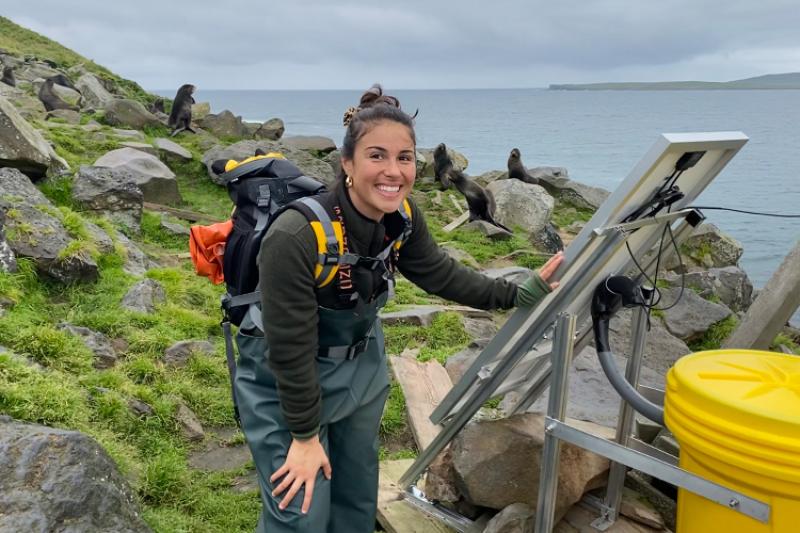What is your role within the NOAA Fisheries Pacific Islands Regional Office?
I am the Oʻahu marine wildlife response coordinator. My job is to coordinate a team to respond to issues with Hawaiian monk seals, whales, dolphins, and occasionally sea turtles. A lot of that is connecting with native and local communities to learn more about some of those hot spot areas where issues may often occur.
How did you get interested in marine animals, and how did it lead you here?
I spent most of my childhood in the ocean surfing, scuba diving, and paddling in Hawaiʻi. Naturally, I knew I wanted to work in a profession where I could focus on protecting our marine ecosystem for the next generation to enjoy. Marine mammals, in particular, have always fascinated me since they have their own unique and complex cultures, social structures, and languages—just like we do! After high school, using my dual citizenship I moved to Aotearoa/New Zealand to get my bachelor’s in biology and master’s in marine conservation.
My first job was working in the New Zealand government as a fisheries policy analyst, mainly focused on marine protected areas. A lot of my job was bringing together other agencies and different internal teams, such as fisheries management, science, and customary experts, to navigate the varied interests. I was really interested in the customary team who were the bridge between the New Zealand government and local iwi (tribes) to uphold our obligation to Māori fishery rights. They invited me to join their team, and I became a senior customary fisheries analyst. I attended iwi fishery meetings to understand where we were falling short on our relationships, and then worked on creating tools and structures for our agency to improve our communication channels and meeting cultural protocols.
I then moved to Alaska where I started with NOAA as a marine mammal specialist. I focused on co-managing northern fur seals with the tribes on the Pribilof Islands. We worked together on research projects of fur seal monitoring, and collaborated on what management plans and research we wanted to prioritize over the next 10 years. When I felt like it was time to come home to Oʻahu, I was so happy to see this position available and am currently settling into my new role.
What is your favorite marine animal and why?
My favorite animal has to be the mighty orca! They’re social, and family dynamics are so cool. I finally got to see killer whales while I was living in Alaska, and they definitely lived up to my expectations.
What’s a memorable experience you’ve had with marine mammals?
Last year, I got to do northern fur seal population surveys on the Pribilof Islands led by the Seattle Marine Mammal Lab. Part of that work required animal handling where we gave fur seal pups haircuts (for identification), and weighed and sexed them. In two weeks, I handled well more than a thousand pups! They can be pretty vicious when you pick them up, and the rookeries themselves can be dangerous with the bull seals. The fur seal whisperer team at the lab taught us how to properly handle them and kept us safe from the bull fur seals. Their help made the whole experience super fun, and it made me much more confident in my seal-handling skills.
Is there a book, quote, or person that influenced you to be the person that you are today?
Definitely my mom. She is a retired medical doctor, expert in traditional Samoan medicine, and now a farmer and village chief. What I’m most impressed by is her ability to lead with so much warmth and encouragement. She believes that every single person has something to bring to the table, and it’s about finding the right environment for them to shine their brightest. I really resonate with that, too, and am appreciative to have her as an example as I continue to develop my own strategies for pulling more seats to the table.
What advice would you have for youth interested in a career with NOAA Fisheries?
I think we get a lot of advice about getting good grades, going to a good college, and hunting for volunteer or internship opportunities, which I believe are all true! What I would add to that is to also look into your upbringing and your own local knowledge you’ve acquired. There could be something within your culture, your family history, sports you grew up doing, or even your knowledge of your local surf break that could help to solve a problem.




